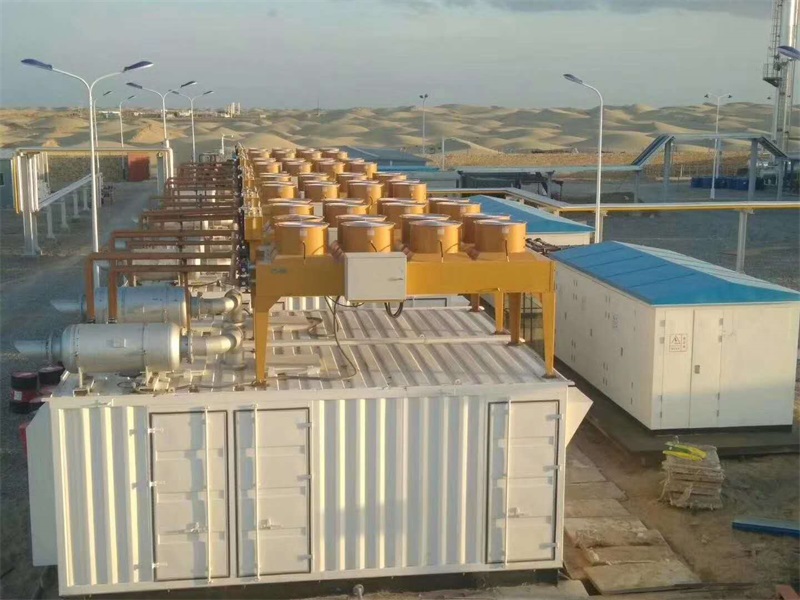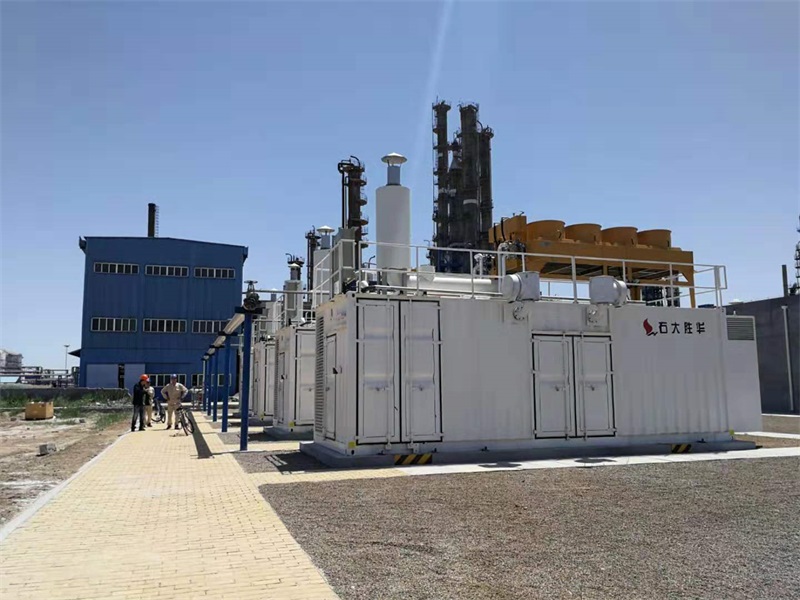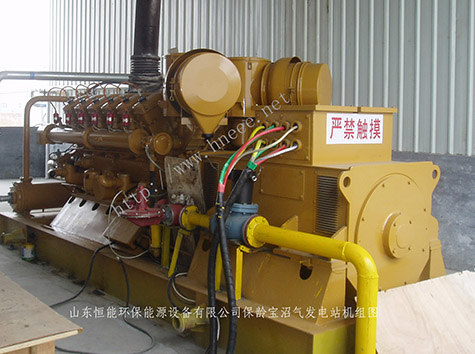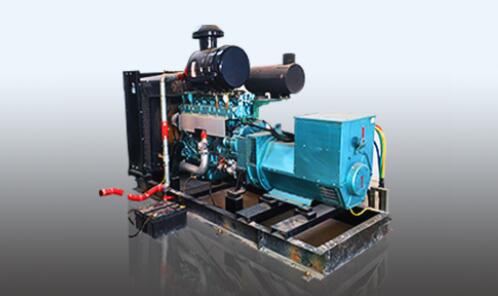沼氣預(yù)處理對沼氣發(fā)電機組的影響
利用沼氣發(fā)電過程中,由于沼氣發(fā)電機組本身設(shè)計和材料的特點,導(dǎo)致發(fā)電機組對沼氣中的部分成分(如H2S、水分、固體雜質(zhì)等)特別敏感,如果處理不好將導(dǎo)致發(fā)電機組無法正常運行。
In the process of using biogas for power generation, due to the design and material characteristics of the biogas generator unit, it is particularly sensitive to some components in the biogas (such as H2S, moisture, solid impurities, etc.). If not handled properly, it will cause the generator unit to be unable to operate normally.
1 硫化氫對發(fā)電機組的影響
The impact of hydrogen sulfide on generator sets
硫化氫(H2S)是一種無色有毒的可燃性氣體,具有強烈的臭雞蛋氣味,當(dāng)空氣中硫化氫的體積含量超過0.1%時,就能引起頭疼暈眩等中毒癥狀。硫化氫(H2S)對鐵等金屬有強腐蝕性,也易吸附金屬表面與多種金屬離子作用,生成不溶于水的硫化物沉淀。沼氣在燃燒時,其中的H2S還能轉(zhuǎn)化為腐蝕性很強的亞硫酸氣霧會污染環(huán)境和腐蝕機器設(shè)備,同時H2S在潮濕的環(huán)境下對金屬管道、燃燒設(shè)備、檢測設(shè)備和儀表等都具有強烈的腐蝕性,所以沼氣在利用前必須脫出其中所含的H2S。利用沼氣發(fā)電時沼氣中的硫化氫會對沼氣發(fā)電機組的進氣管道、增壓器、中冷器、火花塞、氣缸套、排氣管和消音器等造成嚴重腐蝕影響機組壽命。所以沼氣在進入發(fā)電機組之前必須進行沼氣預(yù)處理,將H2S降到機組允許的范圍內(nèi)才能保證機組的可靠運行。
Hydrogen sulfide (H2S) is a colorless, toxic, flammable gas with a strong odor of rotten eggs. When the volume content of hydrogen sulfide in the air exceeds 0.1%, it can cause poisoning symptoms such as headaches and dizziness. Hydrogen sulfide (H2S) has strong corrosiveness to metals such as iron and is also prone to adsorbing metal surfaces and interacting with various metal ions to form insoluble sulfide precipitates. When biogas is burned, the H2S in it can also be converted into highly corrosive sulfite mist, which can pollute the environment and corrode machinery and equipment. At the same time, H2S has strong corrosiveness to metal pipelines, combustion equipment, detection equipment, and instruments in humid environments. Therefore, before biogas can be used, the H2S contained in it must be removed. The hydrogen sulfide in the biogas will cause serious corrosion to the intake pipe, supercharger, intercooler, spark plug, cylinder liner, exhaust pipe and silencer of the biogas generator set when generating power with biogas, and affect the service life of the unit. So before biogas enters the generator unit, it must undergo biogas pretreatment to reduce H2S to the allowable range of the unit in order to ensure the reliable operation of the unit.
2 水分對發(fā)電機組的影響
2. The impact of moisture on generator sets
在利用沼氣發(fā)電過程中,沼氣水分含量過大的話,會導(dǎo)致發(fā)電機組的進氣壓力損耗過大,嚴重的情況下,會引起發(fā)動機功率波動、敲缸、停機等嚴重地影響其使用壽命。其具體表現(xiàn)為:
In the process of using biogas for power generation, if the moisture content of biogas is too high, it will lead to excessive loss of intake pressure of the generator set. In severe cases, it can cause engine power fluctuations, cylinder knocking, shutdown, and seriously affect its service life. Its specific manifestation is:
(a)發(fā)動機點火困難;
(a) Difficulty in engine ignition;
(b)降低燃燒室溫度,降低內(nèi)燃機的效率;
(b) Reduce the temperature of the combustion chamber and reduce the efficiency of the internal combustion engine;
(c)由于水蒸氣等無功氣體的存在,增壓耗功增大;
(c) Due to the presence of reactive gases such as water vapor, the power consumption of turbocharging increases;
(d)水蒸氣與其他酸性物質(zhì)的化合產(chǎn)生中間產(chǎn)物,對機器本身產(chǎn)生腐蝕,縮短機器的使用壽命,降低機器的可靠性。
(d) The combination of water vapor and other acidic substances produces intermediate products that corrode the machine itself, shorten its service life, and reduce its reliability.
3 固體雜質(zhì)對發(fā)電機組的影響
3. The impact of solid impurities on the generator set
粉塵是大氣環(huán)境中涉及面更廣、危害更嚴重的一種污染物。粉塵是發(fā)動機明確限制的雜質(zhì),它主要影響在于:
Dust is the most widespread and harmful pollutant in the atmospheric environment. Dust is a clearly restricted impurity in engines, and its main impact is:
(a)堵塞管路,流通不暢,加大壓損,增加運行費用;
(a) Blocking the pipeline, poor circulation, increased pressure loss, and increased operating costs;
(b)增大機械磨損,降低設(shè)備使用壽命。
(b) Increase mechanical wear and reduce equipment service life.
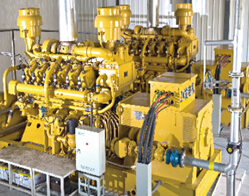

解決方案
Solution
針對發(fā)動機對沼氣的要求,在沼氣發(fā)動機前安裝處理系統(tǒng)以解決了氣源側(cè)與用氣側(cè)的矛盾是目前解決沼氣發(fā)電機組利用問題的有效方法,主要表現(xiàn)在以下兩個方面:
In response to the requirements of the engine for biogas, installing a processing system in front of the biogas engine to solve the contradiction between the gas source side and the gas consumption side is currently an effective method to solve the utilization problem of biogas generator sets, mainly manifested in the following two aspects:
1 降低氣體的相對濕度
1. Reduce the relative humidity of the gas
水分的脫除,考慮到具體的情況,簡單分為凝結(jié)水的脫除以及未凝結(jié)水脫除兩大部分,前者可以采用汽水分離器來實現(xiàn),后者的實現(xiàn)較為復(fù)雜,目前主要有下面幾種方式:
The removal of moisture, considering specific circumstances, can be simply divided into two parts: the removal of condensed water and the removal of uncondensed water. The former can be achieved by using a steam water separator, while the latter is more complex to achieve. Currently, there are mainly the following methods:
(a)低溫除濕:通過制冷設(shè)備降低氣體的溫度,使得其中的水蒸氣凝結(jié),然后排除系統(tǒng);
(a) Low temperature dehumidification: By using refrigeration equipment to reduce the temperature of the gas, the water vapor inside is condensed and then discharged from the system;
(b)吸附:采用對水有較強吸附作用的吸附劑,將氣體中的水分析出;
(b) Adsorption: Use an adsorbent with strong adsorption effect on water to analyze the water in the gas;
(c)膜過濾:采用特殊結(jié)構(gòu)的膜材料,在特定的條件下將水從氣體中分出。
(c) Membrane filtration: A membrane material with a special structure is used to separate water from the gas under specific conditions.
2 降低氣體雜質(zhì)成分含量
2. Reduce the content of gas impurities
氣體中的雜質(zhì)是比較復(fù)雜的成分,由于是針對發(fā)動機的利用,所以對雜質(zhì)的判斷主要以發(fā)動機的要求為準,主要有下面幾種:
Impurities in gases are relatively complex components, and as they are specific to the utilization of the engine, the determination of impurities is mainly based on the requirements of the engine, including the following:
(a)硫的去除:
(a) Sulfur removal:
以硫化氫為主的硫化物的去除主要有物理、化學(xué)以及生物三種方式。其中物理方法主要指物理吸附方式脫硫,這種方式操作簡便,但往往需要占地較大的設(shè)備,而且吸附劑需要再生?;瘜W(xué)方式指以化學(xué)反應(yīng)的方式將硫固化下來,目前有干法及濕法,其差別主要是反應(yīng)物的物理形態(tài)是固體還是液體的差別。生物法脫硫是目前比較新興的一種方式,其主要原理是在反應(yīng)罐中培養(yǎng)出合適的菌種,這些菌種以硫化物為養(yǎng)料,將其中的硫固定下來。 對于硫含量不高的氣體,采用物理吸附或者干法脫硫一般比較經(jīng)濟實用,而且操作簡便。
The removal of sulfides mainly composed of hydrogen sulfide mainly involves three methods: physical, chemical, and biological. The physical method mainly refers to the physical adsorption method for desulfurization, which is easy to operate but often requires a large area of equipment, and the adsorbent needs to be regenerated. Chemical method refers to the solidification of sulfur through chemical reactions. Currently, there are dry and wet methods, and the main difference is whether the physical form of the reactant is solid or liquid. Biological desulfurization is currently a relatively emerging method, whose main principle is to cultivate suitable bacterial strains in reaction tanks, which use sulfides as nutrients to fix the sulfur in them. For gases with low sulfur content, using physical adsorption or dry desulfurization is generally more economical and practical, and the operation is simple.
此外,根據(jù)我國的環(huán)保標(biāo)準規(guī)定:沼氣作為能源利用時,沼氣中的H2S含量不得超過200mg/Nm3。因此沼氣經(jīng)過脫硫處理后需要采用沼氣分析儀對沼氣中H2S含量進行實時在線監(jiān)測,為業(yè)主提供實時準確的數(shù)據(jù)參考,幫助其對沼氣預(yù)處理工藝進行優(yōu)化調(diào)整,提高沼氣發(fā)電機組進氣品質(zhì),以保證H2S含量達到沼氣發(fā)電的要求。
In addition, according to China's environmental standards, when biogas is used as energy, the H2S content in biogas should not exceed 200mg/Nm3. Therefore, after the desulfurization treatment of biogas, a biogas analyzer needs to be used for real-time online monitoring of the H2S content in the biogas, providing real-time and accurate data reference for the owner, helping them optimize and adjust the biogas pretreatment process, improve the intake quality of the biogas generator unit, and ensure that the H2S content meets the requirements of biogas power generation.
由于沼氣成分復(fù)雜,除H2S外還含有CH4、CO2、O2等氣體成分,如果要保證沼氣發(fā)電機組的沼氣品質(zhì),提高沼氣熱值,保證沼氣燃燒發(fā)電效率,除了要降低H2S含量,通過監(jiān)測沼氣中CH4、CO2的濃度,為優(yōu)化厭氧發(fā)酵工藝,提高CH4含量,降低CO2含量提供參考依據(jù),也是十分必要的。
Due to the complex composition of biogas, in addition to H2S, it also contains gas components such as CH4, CO2, O2, etc. If we want to ensure the quality of biogas in the biogas generator unit, increase the calorific value of biogas, and ensure the efficiency of biogas combustion and power generation, it is necessary to reduce the H2S content. By monitoring the concentration of CH4 and CO2 in biogas, it is also necessary to provide a reference basis for optimizing anaerobic fermentation process, increasing CH4 content, and reducing CO2 content.
感謝您的閱讀,此文的文章來源:沼氣發(fā)電機組更多的內(nèi)容和問題請點擊: http://www.pp198.cn我們會繼續(xù)努力的為您提供服務(wù),感謝您的支持!
Thank you for reading. The source of this article is biogas generator units. For more information and questions, please click on: http://www.pp198.cn We will continue to work hard to provide you with services. Thank you for your support!
 在線咨詢
在線咨詢 官方二維碼
官方二維碼




 當(dāng)前位置:
當(dāng)前位置: 2023.06.06
2023.06.06
